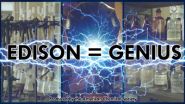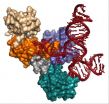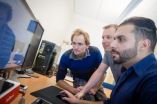(Press-News.org) A study by Belgian doctoral researcher Wouter De Haes (KU Leuven) and colleagues provides new evidence that metformin, the world's most widely used anti-diabetic drug, slows ageing and increases lifespan.
In experiments reported in the journal Proceedings of the National Academy of Sciences, the researchers tease out the mechanism behind metformin's age-slowing effects: the drug causes an increase in the number of toxic oxygen molecules released in the cell and this, surprisingly, increases cell robustness and longevity in the long term.
Mitochondria – the energy factories in cells – generate tiny electric currents to provide the body's cells with energy. Highly reactive oxygen molecules are produced as a by-product of this process.
While these molecules are harmful because they can damage proteins and DNA and disrupt normal cell functioning, a small dose can actually do the cell good, say the researchers: "As long as the amount of harmful oxygen molecules released in the cell remains small, it has a positive long-term effect on the cell. Cells use the reactive oxygen particles to their advantage before they can do any damage," explains Wouter De Haes. "Metformin causes a slight increase in the number of harmful oxygen molecules. We found that this makes cells stronger and extends their healthy lifespan."
It was long thought that harmful reactive oxygen molecules were the very cause of ageing. The food and cosmetics industries are quick to emphasise the 'anti-ageing' qualities of products containing antioxidants, such as skin creams, fruit and vegetable juices, red wine and dark chocolate.
But while antioxidants do in fact neutralise harmful reactive oxygen molecules in the cell, they actually negate metformin's anti-ageing effects because the drug relies entirely on these molecules to work.
The researchers studied metformin's mechanism in the tiny roundworm Caenorhabditis elegans, an ideal species for studying ageing because it has a lifespan of only three weeks. "As they age, the worms get smaller, wrinkle up and become less mobile. But worms treated with metformin show very limited size loss and no wrinkling. They not only age slower, but they also stay healthier longer," says Wouter De Haes. "While we should be careful not to over-extrapolate our findings to humans, the study is promising as a foundation for future research."
Other studies in humans have shown that metformin suppresses some cancers and heart disease. Metformin could even be an effective drug for counteracting the general effects of ageing, say the researchers.
INFORMATION:
The study was carried out by Wouter De Haes under the supervision of Liesbet Temmerman and Professor Liliane Schoofs (KU Leuven) and in close collaboration with Professor Bart Braeckman (Ghent University).
Anti-diabetic drug slows aging and lengthens lifespan
2014-06-02
ELSE PRESS RELEASES FROM THIS DATE:
Marijuana shows potential in treating autoimmune disease
2014-06-02
A team of University of South Carolina researchers led by Mitzi Nagarkatti, Prakash Nagarkatti and Xiaoming Yang have discovered a novel pathway through which marijuana can suppress the body's immune functions. Their research has been published online in the Journal of Biological Chemistry.
Marijuana is the most frequently used illicit drug in the United States, but as more states legalize the drug for medical and even recreational purposes, research studies like this one are discovering new and innovative potential health applications for the federal Schedule I drug. ...
Shape matters...
2014-06-02
Which look bigger, packages of complicated shape or packages of simple shape? Some prior research shows that complex packages appear larger than simple packages of equal volume, while other research has shown the opposite - that simple packages look bigger than the more complex. US researchers, writing in the International Journal of Management Practice believe they have resolved this dilemma.
Lawrence Garber of Elon University in North Carolina and Eva Hyatt and Ünal Boya of Appalachian State University report that human beings are just not very good at estimating the ...
Carnegie Mellon researchers discover social integration improves lung function in elderly
2014-06-02
PITTSBURGH—It is well established that being involved in more social roles, such as being married, having close friends, close family members, and belonging to social and religious groups, leads to better mental and physical health. However, why social integration — the total number of social roles in which a person participates — influences health and longevity has not been clear.
New research led by Carnegie Mellon University shows for the first time that social integration impacts pulmonary function in the elderly. Lung function, which decreases with age, is an important ...
Study suggests fast food cues hurt ability to savor experience
2014-06-02
Toronto – Want to be able to smell the roses?
You might consider buying into a neighbourhood where there are more sit-down restaurants than fast-food outlets, suggests a new paper from the University of Toronto's Rotman School of Management.
The paper looks at how exposure to fast food can push us to be more impatient and that this can undermine our ability to smell the preverbal roses.
One study, surveyed a few hundred respondents throughout the US on their ability to savor a variety of realistic, enjoyable experiences such as discovering a beautiful waterfall on ...
Gene therapy combined with IMRT found to reduce recurrence for select prostate cancer patients
2014-06-02
Fairfax, Va., June 2, 2014—Combining oncolytic adenovirus-mediated cytotoxic gene therapy (OAMCGT) with intensity modulated radiation therapy (IMRT) reduces the risk of having a positive prostate biopsy two years after treatment in intermediate-risk prostate cancer without affecting patients' quality of life, according to a study published in the June 1, 2014 edition of the International Journal of Radiation Oncology • Biology • Physics (Red Journal), the official scientific journal of the American Society for Radiation Oncology (ASTRO).
Previous prospective ...
How Thomas Edison laid the foundation for the modern lab (video)
2014-06-02
WASHINGTON, June 2, 2014 — Thomas Edison is hands-down one of the greatest inventors in history. He also had a love of chemistry that banished him to the basement as a kid. This week, the Reactions team went behind the scenes at the Thomas Edison National Historical Park to see how Edison's love of chemistry fueled his world-changing inventions. Recently named a National Historic Chemical Landmark, the complex is home to more than 400,000 artifacts (which we definitely weren't allowed to touch) and is considered the template for modern research-and-development labs everywhere. ...
Scientists capture most detailed images yet of humans' tiny cellular machines
2014-06-02
MADISON, Wis. — A grandfather clock is, on its surface, a simple yet elegant machine. Tall and stately, its job is to steadily tick away the time. But a look inside reveals a much more intricate dance of parts, from precisely-fitted gears to cable-embraced pulleys and bobbing levers.
Like exploring the inner workings of a clock, a team of University of Wisconsin-Madison researchers is digging into the inner workings of the tiny cellular machines called spliceosomes, which help make all of the proteins our bodies need to function. In a recent study published in the journal ...
Computer scientists develop tool to make the Internet of Things safer
2014-06-02
Computer scientists at the University of California, San Diego, have developed a tool that allows hardware designers and system builders to test security- a first for the field. One of the tool's potential uses is described in the May-June issue of IEEE Micro magazine.
"The stakes in hardware security are high", said Ryan Kastner, a professor of computer science at the Jacobs School of Engineering at UC San Diego.
There is a big push to create the so-called Internet of Things, where all devices are connected and communicate with one another. As a result, embedded ...
NASA's TRMM satellite sees Eastern Pacific tropical cyclone forming
2014-06-02
VIDEO:
This 3-D animated fly-by of developing tropical low pressure System 93E on June 2 revealed the highest thunderstorms (in red) as it continues to develop.
Click here for more information.
There's a new tropical low pressure area brewing in the Eastern Pacific and NASA's TRMM satellite flew overhead and got a read on its rainfall rates and cloud heights.
The eastern Pacific Ocean has become active on cue with the start of the hurricane season in that area. Only a few days ...
Laser device can detect alcohol in cars, say authors in Journal of Applied Remote Sensing
2014-06-02
BELLINGHAM, Washington, USA — A new open-access article in the Journal of Applied Remote Sensing is garnering attention for research that could aid in the campaign to prevent drunk driving: a device that can detect alcohol in cars. The Journal of Applied Remote Sensing is published by SPIE, the international society for optics and photonics.
The article "Stand-off detection of alcohol in car cabins," by Jarosław Młyńczak, Jan Kubicki, and Krzysztof Kopczyński of the Military University of Technology in Warsaw, details experiments using an external ...





